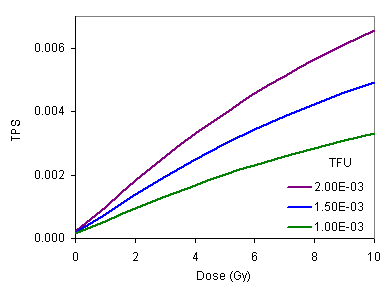
 | ||||||
| Tutorial#15: Parameters TFS, TFU, TMAX and TSTP in the genome instability and neoplastic transformation model. Overview |
This set of parameters (under the keyword NEO) provide cell dependent information pertaining to cell transformation. The effect of TFU, the transformation rate for cells with enhanced genomic instability on the genomic instability per surviving fraction (EGI/SF) and transformation frequency per survivor (TPS) are analyzed. |
Example 14.2 Effect of the transformation rate for cells with enhanced genomic instability (TFU) on the behavior of transformation frequency per survivor (TPS) (E.g. rmrsim9.inp -> rmrsim9.out).  Variation of TPS with the absorbed radiation dose for varying TFU. Comments: The transformation frequency (represented by TPS) increases with increasing absorbed dose and TFU. Suggested problems Variation of TPS with the absorbed radiation dose for varying TFU. Comments: The transformation frequency (represented by TPS) increases with increasing absorbed dose and TFU. Suggested problems
Tip: Experiment by changing the various model parameters and physically interpreting your results. |
| School of Health Sciences Purdue University Disclaimer | Last updated: 10 June, 2011 |